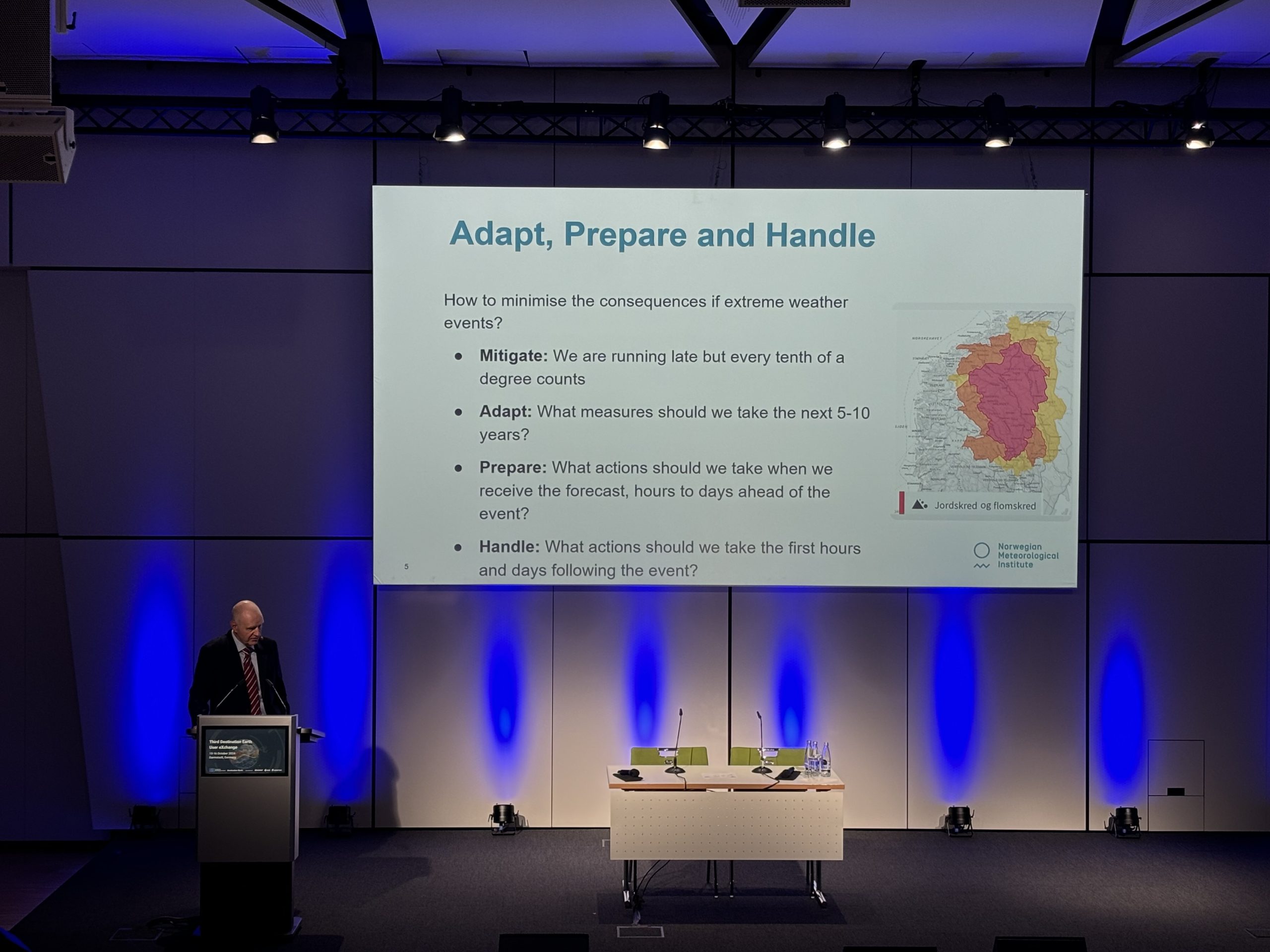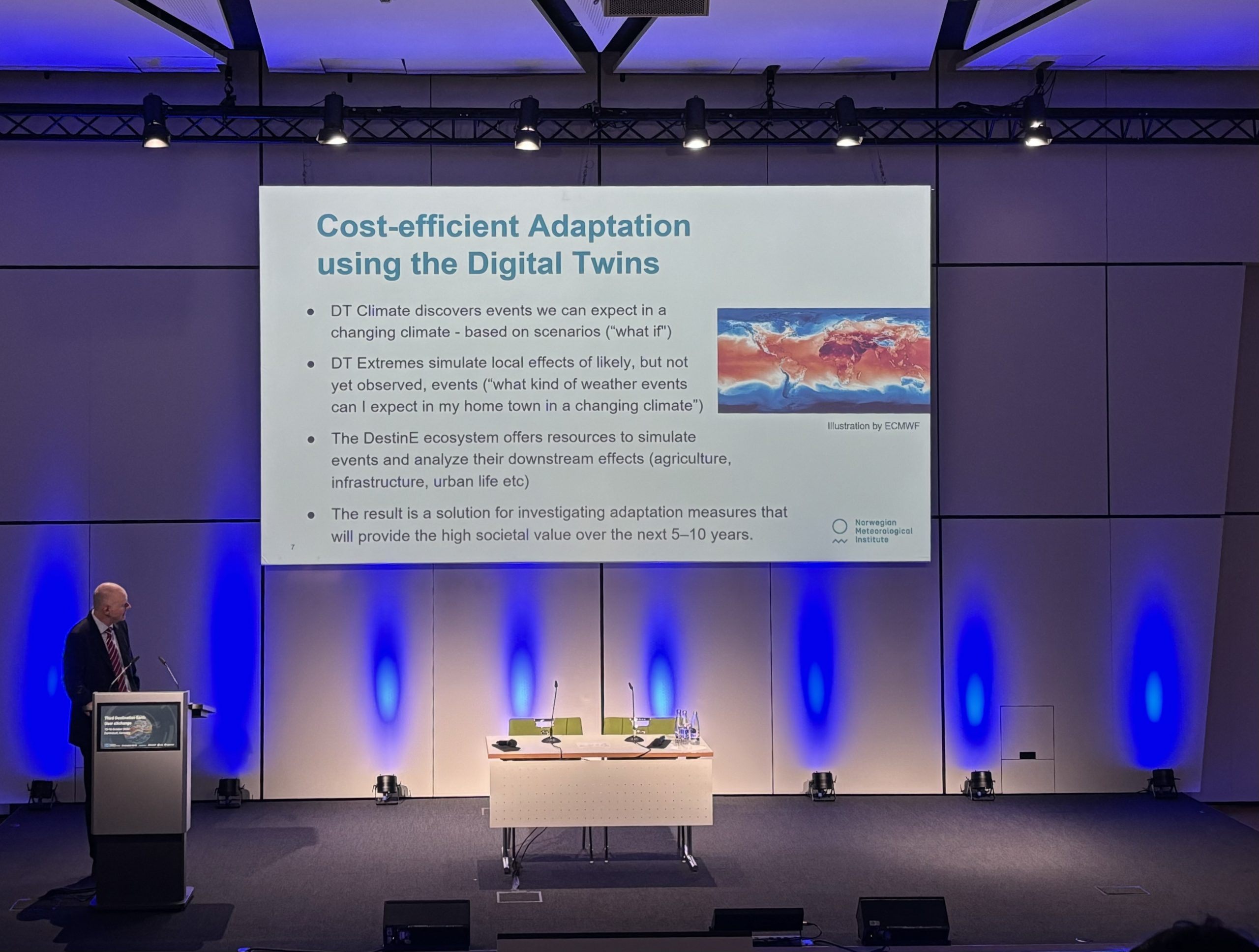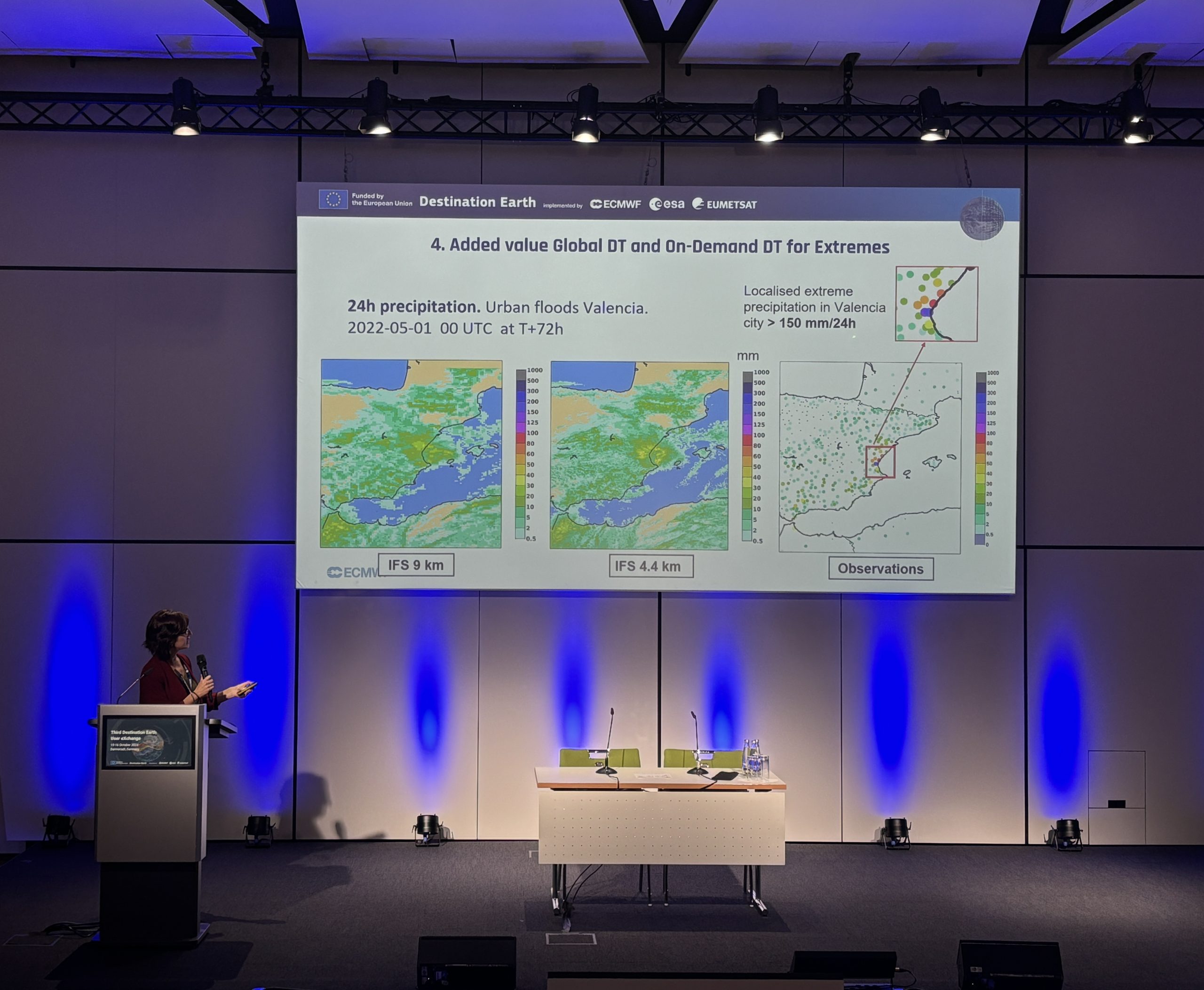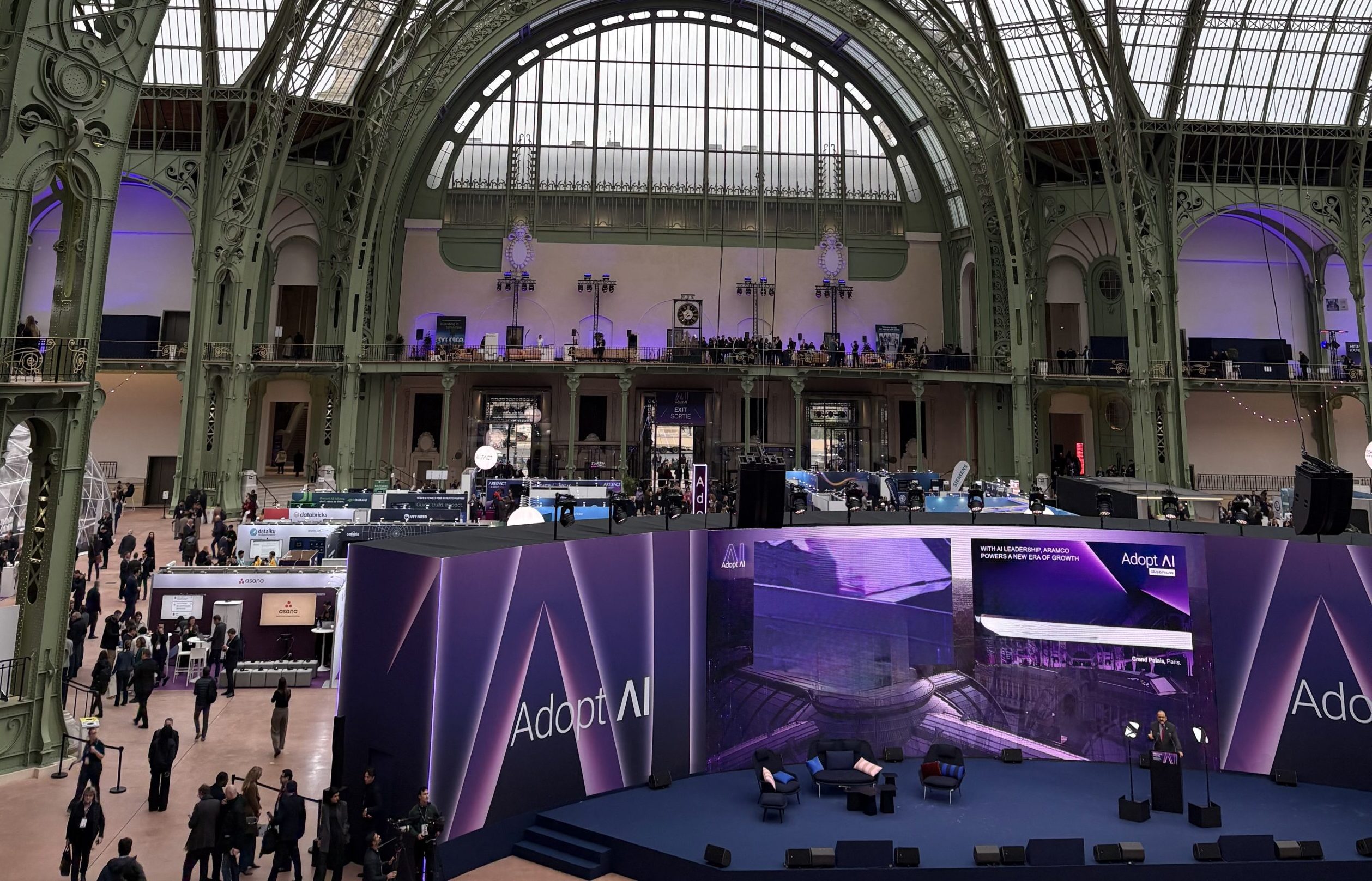
“Over the last 30 months, working with 90 partner institutions from 26 Countries and using the power of the world leading supercomputing facilities of the EuroHPC Joint Undertaking, we have set up a unique bespoke simulation capability which allows us to assess the impact of certain extreme events and climate scenarios. From the start we have developed the Destination Earth digital twins following a co-design approach, and that’s why events like the User eXchange are so important, to get continuous feedback and engage with the users.”
Irina Sandu, Director for Destination Earth at ECMWF.
The third User eXchange meeting held, on 15-16 October 2024 in Darmstadt, Germany, gathered more than 270 participants on-site at the Darmstadtium Science and Congress Center and roughly as many online. The event hosted by EUMETSAT and co-organised with ECMWF and the European Space Agency (ESA), highlighted the fast-paced evolution of the Destination Earth (DestinE) initiative of the European Commission, implemented by ECMWF, ESA and EUMETSAT under the leadership of the Directorate-General for Communications Networks Content and Technology (DG CNECT).
The welcome speeches from Lothar Wolf, DestinE Programme Manager at EUMETSAT and Liina Munari, Deputy Head of Unit C1 (High Performance Computing and Applications) at the EU Commission’s DG CNECT highlighted the work of everyone involved in the initiative. Notably, the fast-paced development of the system during the first phase (2022-2024) demonstrated the value of working together. Munari also announced that following the launch of Destination Earth in June of this year, the platform is now open for registrations.
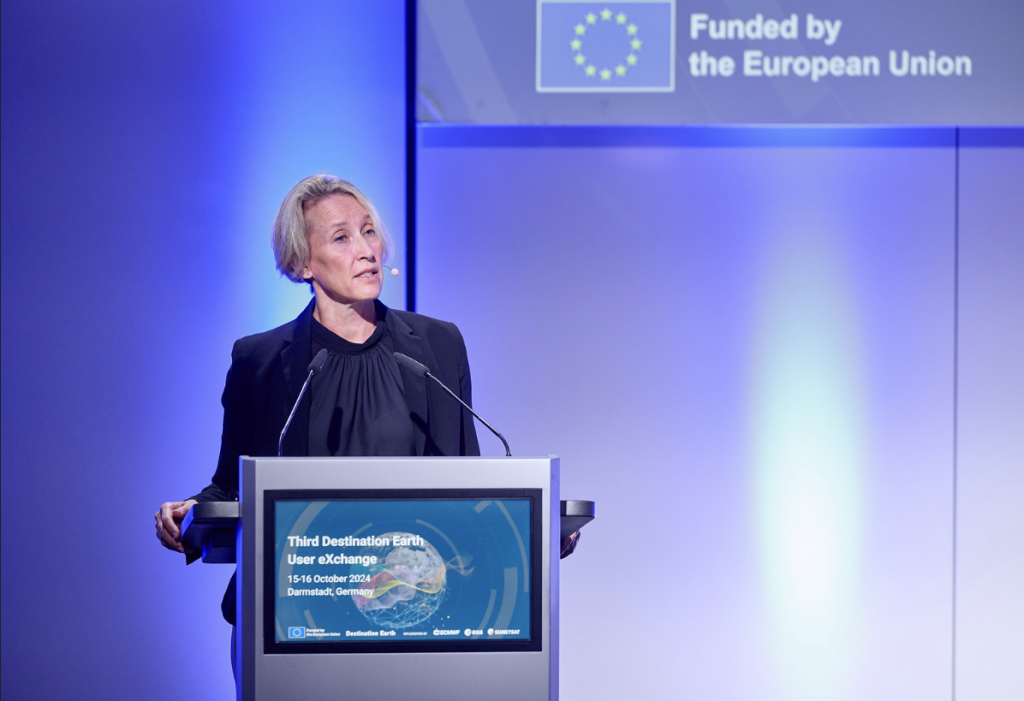
A tool for adaptation to anticipate the impact of extremes
The director of the Norwegian Meteorological Institute (MET Norway) Roar Skålin set the scene for the two-day meeting in a keynote presentation. He outlined the pressing need for a system such as DestinE amid an increase in the impact of unprecedented extreme weather events fueled by climate change, citing examples from Norway like storm Hans in 2023. Skålin also called for an enhanced cooperation between scientists and policymakers for better adaptation, preparation and handling of the impacts of climate change and extreme weather.
The MET Norway Director also explained the work of the institute in the development of the Weather-Induced Extremes Digital Twin (Extremes DT), as part of the large consortium led by Météo France selected by ECMWF to develop the on-demand regional component of this Digital Twin.
Roar Skålin from MET Norway during his presentation on extremes in a changing climate.
ECWMF, EUMETSAT and ESA outline progress
Following what is now a tradition of the User eXchange meetings, the three entrusted entities to implement DestinE, ECMWF, ESA and EUMETSAT updated the audience on the development of different components within the system.
Irina Sandu explained how the digital twins on Climate Change Adaptation (Climate DT) and Extremes DT, developed by ECMWF in close partnership with over 90 institutions across Europe, complement existing capabilities and boost our ability to better respond and adapt to challenges posed by extreme events and climate change. DestinE’s Digital Twins set up a flexible modelling and software infrastructure which allows assessing how the Earth system, and extreme events, may evolve depending on various possible scenarios.
She added that this new information will complement the capabilities already available in Europe from the national meteorological and hydrological services and international initiatives such as Copernicus.
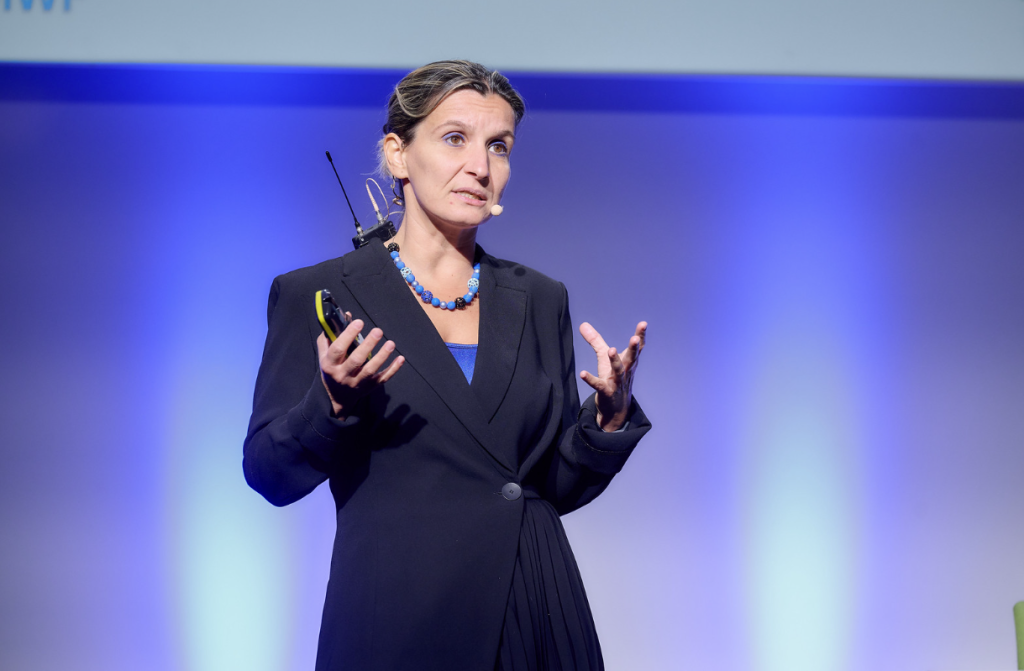
The digital twins are breaking new ground in terms of resolution but are also bringing closer together weather and climate predictions. For the multi-decadal climate projections, we are going from resolutions of 100 km to around 5 km, and this is the resolution at which the global extremes digital twin is running as well. Bridging this resolution gap between weather and climate predictions helps not only to develop the models in a unified and seamless way, but also allows to more explicitly simulate the weather of the future in the climate projections. Gathering statistics of how the weather and extreme events will look like in possible futures from the climate simulations, will help decision-makers better adapt and respond to the challenges of extreme events in a changing climate.
Irina Sandu, Director for Destination Earth at ECMWF
The Climate DT: Operationalising multi-decadal climate projections
In a session on Climate Models and Data, co-host Sebastian Milinski (ECMWF) highlighted the progress of climate simulations performed with the three Climate DT models: ICON, IFS-NEMO, and IFS-FESOM. The Climate DT aims to operationalise the production of multi-decadal global climate simulations several decades ahead using cutting-edge numerical simulations. This allows assessing the impacts of various scenarios or policies on the climate system and relevant impact-sectors.
Theresa Kiszler from CSC showcased the Climate DT objectives, models and simulations and explained the workflow for producing climate simulations and deriving climate information for key impact sectors. Indeed, the workflow includes several impact-sector applications (e.g. a hydrological model or computations of relevant indicators for wind energy) that transform the climate data to actionable information on climate change impacts through a co-design approach. Data reduction tasks (so-called one-pass algorithms) are also important elements of this process. An uncertainty quantification and evaluation framework, AQUA, is also included in the workflow, allowing to assess the quality of the simulations as the models run.
Presenters from the Alfred-Wegener Institute, the Barcelona Supercomputing Center (BSC) and Politecnico di Torino further discussed the simulations currently accessible to users, shared results from their scientific evaluations, and offered examples of how simulation data can be used in practice. The session also included plans for future simulations to be conducted in the coming year.
The Extremes DT: From forecasts to impacts
Benoît Vannière (ECMWF) and Roger Randriamampianina (Norwegian Meteorological Institute) co-chaired a session on the Extremes DT. This digital twin is designed to simulate extreme weather events and their impacts, providing users with insights to rapidly respond to extreme events as they emerge. The objective of the session was to provide a comprehensive overview of the Extremes DT, which is made of two components: the Global DT and the On-Demand DT. The global component consists of simulations at 4.4 km performed with ECMWF IFS, while the on-demand regional component, based on the ACCORD prediction system, can be activated to provide sub-km scale simulations over Europe.
Benoît Vannière and Estíbaliz Gascón from ECMWF showcased workflows of the Extremes DT and success stories.
Xiaohua Yang (Danish Meteorological Institute) presented the workflow of the On-Demand DT, which includes both earth-system and impact-sector models. Since July, the On-Demand DT has been producing approximately two test simulations per day. Jonathan Demaeyer (Royal Meteorological Institute of Belgium) presented the methodology of the novel detection-triggering algorithm used to identify potential extreme events in Europe and configure the domain of the On-Demand simulation. This was illustrated through the case study of the Storm Boris, which caused significant flooding in Central Europe in September 2024. The impact sector models that have already been incorporated into the Extremes DT were presented by Randriamampianina. He indicated that a particular focus will be placed on hydrological extremes during the winter of 2024/25. Aristofanis Tsiringakis (ECMWF) then reviewed possible pathways to quantify uncertainty in the Extremes DT that will be explored in phase II.
To conclude the session, Estíbaliz Gascón (ECMWF) presented success stories from the Extremes DT. The presentation underscored the added value of increasing resolution from 9 km to 4.4 km in predicting certain extreme events, such as tropical cyclones and orographic precipitation, while emphasising ongoing efforts to improve forecasts through uncertainty quantification and sub-kilometre resolutions.
Interacting with the digital twins
The session “Interacting with the Digital Twins” focused on how users and digital twins can interact effectively, and how these systems can communicate with each other. Presentations highlighted key developments within the DestinE initiative that enable these interactions.
James Hawkes (ECMWF) introduced the Digital Twin Engine and its components, which are the central elements that facilitate interoperability and interactivity, allowing users to access and customise digital twin outputs to their specific needs and explore “what-if” scenarios. The different components of the Digital Twin Engine form a cohesive, interactive workflow and bridge the gap between complex data and practical user applications.
Exploring DestinE’s features, data visualisation techniques and energy sector use cases
The programme of the second day was oriented to hands-on workshops and sectoral sessions aimed at introducing users to the features offered by the DestinE Platform, the Data Lake, the Digital Twins and the Digital Twin Engine.
One of the highlights was a session on DestinE in the Energy sector, that showcased the uses of the Climate DT and the Extremes DT through use cases already in place. Scientist Francesc Roura Adserias from BSC, involved in an energy use case using the Climate DT and Irene Schicker from GeoSphere Austria, who works with the Extremes DT for the renewable energy sector, moderated the session.
Roura Adserias showcased the capability of the Climate DT to provide global climate information with local granularity, tailored for the specific needs of the renewable energy sector. The Climate DT provides solutions to dealing with the vast amount of climate data from climate projections by computing key energy-relevant indicators while the simulations run. It provides for example wind turbine capacity factors and the future expected frequency of high- and low- wind speed events, allowing to assess changes in future energy production. This avoids the need for costly post-processing after the simulations are complete.
ECMWF scientist Andreas Müller showcased some of the impressive visualisations of the Climate DT simulations he realised using Unreal Engine, in a session focusing on data visualisation techniques. The techniques Andreas presented allow to explore interactively the vast amount of data from the Climate DT simulations, highlighting the local granularity of these global multi-decadal simulations. ECMWF contractor Exprivia also showed some of the prototype visualisations being developed based on Extremes and Climate DT data.
Exploring AI and machine learning in DestinE
Scientists from the three implementing entities, national services and institutions demonstrated and debated on the hot topic of the application of artificial intelligence and machine learning (ML/ AI) in DestinE. The session, co-chaired by ECMWF scientist Mariana Clare and EUMETSAT’s Miruna Stoicescu, explored how these new techniques are complementing traditional approaches with a wide scope of application areas, from uncertainty quantification of the simulations to impact sector reach and interactivity.
ECMWF Joffrey Dumont Le Brazidec gave a brief overview of the AI activities carried out by ECMWF and its partners in the second phase of DestinE. These include developing an ML-based Earth system model, as well as a Forecast-in-a-box prototype, that provides data-retrieval, forecasting and post-processing tools without the need for complex and costly computation hardware. Compared to the traditional physics-based models, data driven models can perform forecasts and simulations at very low computing and economic costs and much faster.
A particular need in DestinE is to be able to quantify uncertainties, for example regarding extreme events. For this, you need a lot of forecasts with different initial conditions, which is very expensive to run with physics-based models at very high resolutions such as those used in DestinE’s Digital Twins. That’s where AI based models can provide significant help.
Joffrey Dumont Le Brazidec, Machine Learning and Uncertainty Quantification Scientist at ECMWF
The overview of the ML/ AI activities at ECMWF in the framework of DestinE included other ongoing projects like the development of ML demonstrators for the sectors most affected by weather extremes, a climate emulator and a weather and climate chatbot.
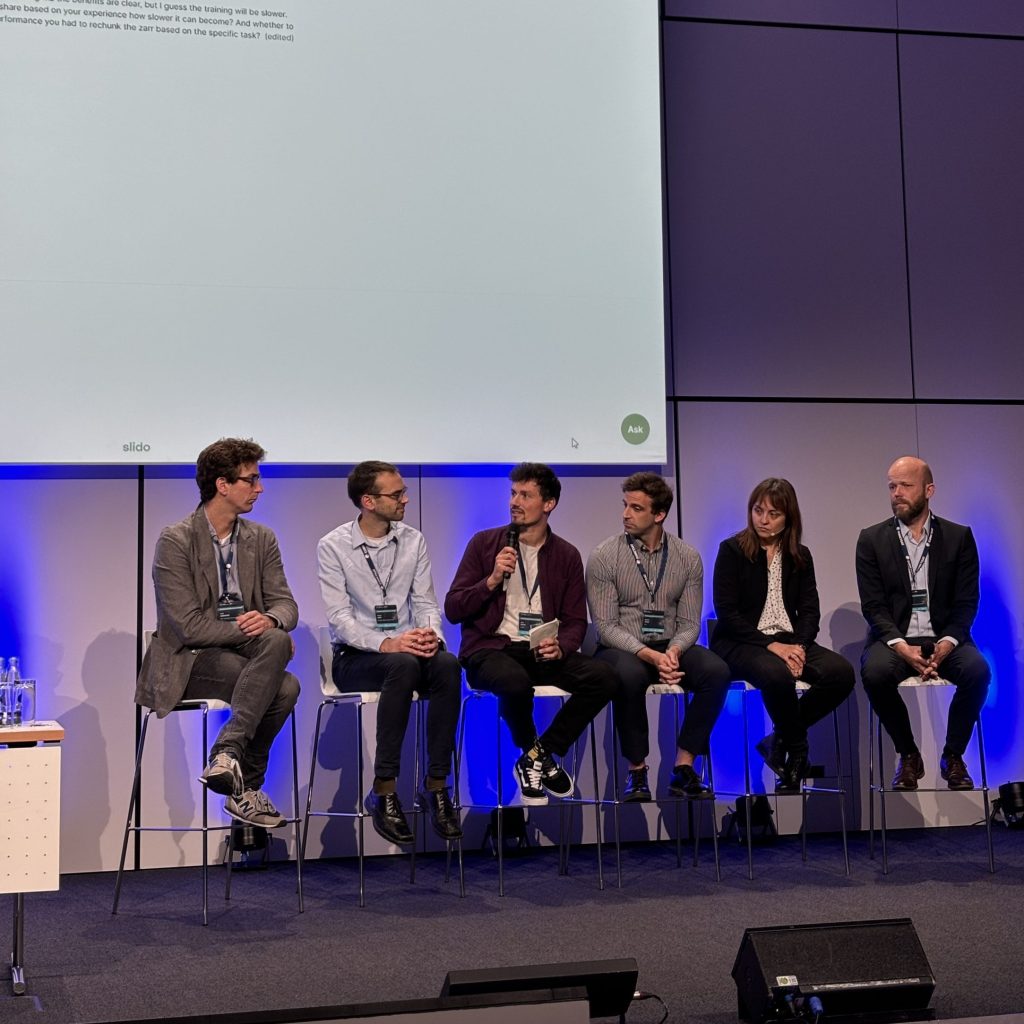
Similarly, Thomas Nipen from MET Norway presented exciting results from the efforts in the On-Demand regional Extremes DT, to pilot a regional ML-based prediction capability building on ECMWF AIFS model and Anemoi software framework, to support uncertainty quantification through cheaper ML-based forecasts for this DT, that will produce cheaper, faster and sometimes more accurate forecasts than the traditional models used in Numerical Weather Prediction (NWP).
A paper recently published in preprint and co-authored by scientists from ECMWF and the Alfred-Wegener-Institute, Helmholtz Centre for Polar and Marine Research (AWI) demonstrated the out-of-distribution capabilities of three main AI-based weather models (AIFS, Pangu-Weather, GraphCast) when applied in a future possible climate, opening the door to a wide range of applications in climate science.
EUMETSAT is also working on preparing AI ready data to facilitate the integration of heterogeneous datasets in AI models, as well as ML/ AI application to demonstrate the value of EUMETSAT data.
The session ended with a panel discussion of the session speakers on opportunities and challenges of using AI within the DestinE framework. The panel speakers agreed that there are great opportunities for developing AI applications in DestinE and they were confident that future DestinE User eXchanges will showcase even more AI applications.
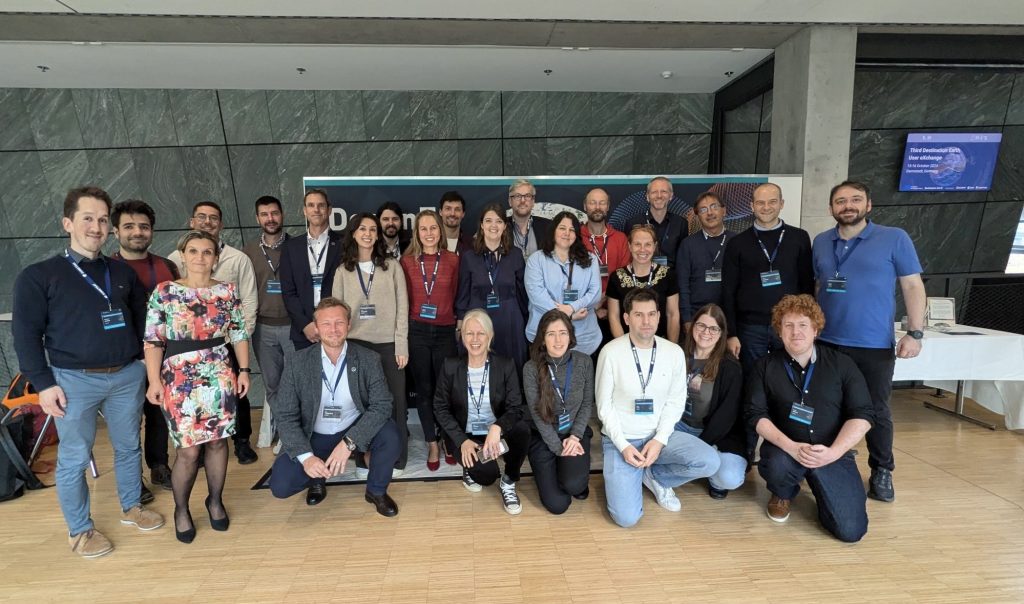
Building the DestinE community through the User eXchange meetings
The User eXchange events are key landmarks in the agenda of the DestinE community. Hosted every several months by each of the implementing entities, the second of these series of events took place in Bonn, hosted by ECMWF. Read more about it here.
This event series is instrumental in fostering a shared understanding of the progress being made and the innovative directions ahead. Jörn Hoffmann, Destination Earth Applications Partnership Lead, concluded that:
The User eXchange gives participants the opportunity to gain new insights into what has been going on in the different parts of DestinE and share their contributions. I think the best thing participants can take away from this event is the sense of excitement that DestinE is progressing very rapidly, and that they are inspired to explore what will be possible with DestinE within the next few years.
ESA will host the fourth DestinE User eXchange next year. More details will be available soon.
Destination Earth is a European Union-funded initiative launched in 2022, with the aim to build a digital replica of the Earth system by 2030. The initiative is being jointly implemented under the leadership of DG CNECT by three entrusted entities: the European Centre for Medium-Range Weather Forecasts (ECMWF), responsible for the creation of the first two ‘digital twins’ and the ‘Digital Twin Engine’, the European Space Agency (ESA) responsible for building the ‘Core Service Platform’, and the European Organisation for the Exploitation of Meteorological Satellites (EUMETSAT), responsible for the creation of the ‘Data Lake’.
We acknowledge the EuroHPC Joint Undertaking for awarding this project strategic access to the EuroHPC supercomputers LUMI, hosted by CSC (Finland), and the LUMI consortium, Marenostrum5, hosted by BSC (Spain) Leonardo, hosted by Cineca (Italy) and MeluXina, hosted by LuxProvide (Luxembourg) through a EuroHPC Special Access call.
More information about Destination Earth is on the Destination Earth website and the EU Commission website.
For more information about ECMWF’s role visit ecmwf.int/DestinE
For any questions related to the role of ECMWF in Destination Earth, please use the following email links:
